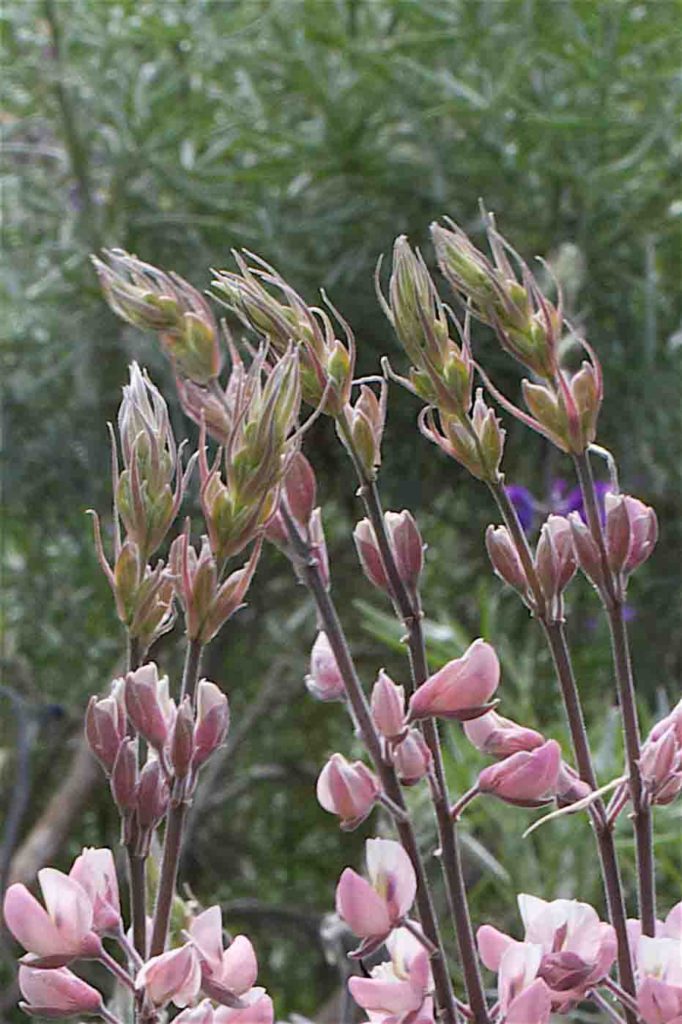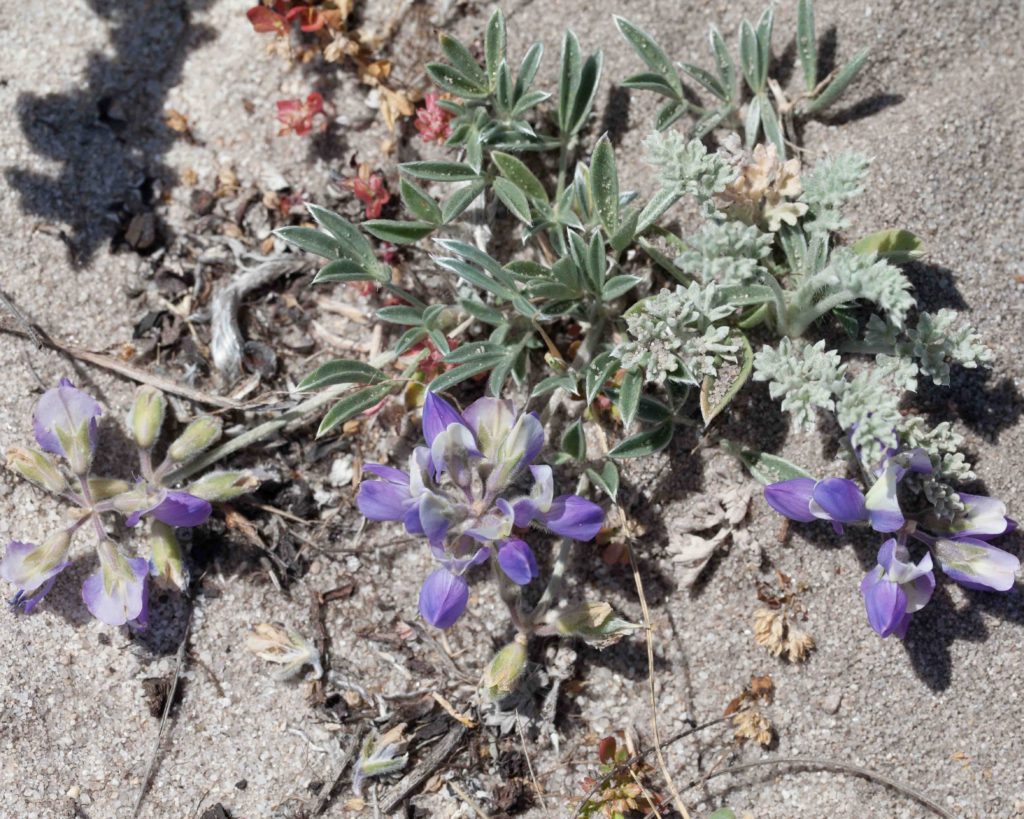Fabaceae: Pea Family — Perennial & Shrubby Lupines
The pea family has 5-petaled flowers, consisting of a wide upper banner petal, two wing petals, plus two lower petals which are fused to form a boat-shaped keel. Many produce heads or spikes, consisting of multiple individual flowers (examples are lupines and clovers). The seed pod is generally a “legume”. This is a long, flattish pod, swollen by the seeds, and splitting lengthwise along both the top and bottom.
Most lupines have distinct clusters of flowers in spikes, sometimes short, sometimes quite tall. Leaves are typically palmately compound, with leaflets ranging from very narrow to broad. It is useful to note whether the flowers are in whorls around the stem. It can also be critical to look at the keel, to see the pattern of hairs. Some are ciliate on both the top and bottom of the keel; some have hairs only near the claw (base), others only near the tip. Photographs of some keels appear below.
Abrams’ Bush Lupine – Lupinus albifrons var. abramsii
Blooms:
May–June
Plant Height:
20–100 cm
Flower Size:
Large cluster
Origin:
Native
Rare or Endangered?
Yes – 3.2
Habitat:
Open woods above 600 m
Notes:
This rare plant is similar to Silver Bush Lupine (Lupinus albifrons var. albifrons, see below). But it has a lower, more compact growth habit, and its flowers are a richer purple. The silvery gray-green leaflets are 1–3 cm long, and woolly to shaggy-hairy. Keels are ciliate on the upper margin from the middle to the tip (see last photo). Photo #3 by CJH.
Silver Bush Lupine – Lupinus albifrons var. albifrons
Blooms:
Mar–June
Plant Height:
0.5–5 m
Flower Size:
Large cluster
Origin:
Native
Habitat:
Common sandy and rocky places
Notes:
Probably the most common Bush Lupine—at least away from the immediate coast. It is a large shrub, with darkish violet to lavender flowers in a cluster up to 30 cm long. Leaves consist of 6–10 silvery, 1–3 cm long leaflets. Leaf stipules are no more than 1 cm long. Flowers are generally not whorled, or if so only loosely. This can be distinguished from the pinkish-purple flowering form of Tree Lupine (Lupinus arboreus, see below) by the color of its leaves. Keels are ciliate on the upper margin, from the middle to the tip (see last photo). This distinguishes it from Summer Lupine (Lupinus formosus, see below), a lower growing species found in similar habitats.
Collin’s Bush Lupine – Lupinus albifrons var. collinus
Blooms:
Mar–June
Plant Height:
20–40 cm
Flower Size:
Large cluster
Origin:
Native
Habitat:
Rocky places inland
Notes:
An uncommon shrub, with leaves and flowers similar to those of Silver Bush Lupine (Lupinus albifrons var. albifrons, see above). However, overall this is much smaller, with prostrate to decumbent stems. There are 6–9 silvery leaflets, 1–3 cm long, with appressed hairs. Keels may be ciliate on the upper margin towards the tip.
Douglas’ Bush Lupine – Lupinus albifrons var. douglasii
Blooms:
Mar–June
Plant Height:
1–2 m
Flower Size:
Large cluster
Origin:
Native
Habitat:
Rocky slopes near coast
Notes:
An uncommon shrub found near the coast, easily confused with Silver Bush Lupine (Lupinus albifrons var. albifrons, see above). The differences are subtle, except for the much shorter flower clusters which are 10–15 cm long. Other differences: the leaves are consistently silver-silky (vs. green to silvery), leaf stipules are 1–2 cm (vs < 1 cm), leaflets are 7–9 (vs 6–10) and 25–45 mm in length (vs 10–30 mm), and the bracts subtending the buds are much longer (10–24 mm vs 4–8 mm), exceeding the buds. Plants may be found that exhibit characteristics of both species, so definitive identifications can be difficult.
Tree / Yellow Bush Lupine – Lupinus arboreus
Blooms:
Apr–July
Plant Height:
up to 2 m
Flower Size:
Large cluster
Origin:
Native
Habitat:
Sandy places near coast, occasionally inland
Notes:
This is by far the commonest shrub lupine in coastal areas, where its flowers are most often bright yellow. But they can be lilac blue, pink or white, often in combination. Plants found away from the immediate coast generally do not have the yellow flowers of coastal plants. In its lilac-blue to pink form, it could be mistaken for Silver Bush Lupine (Lupinus albifrons var. albifrons, see above), except for its consistently green rather than silvery leaves. Flowers may be whorled. Keels are ciliate along the entire upper margin. Photo #2 by CJH.
Silver Beach Lupine – Lupinus chamissonis
Blooms:
Mar–June
Plant Height:
0.5–2 m
Flower Size:
Large cluster
Origin:
Native
Habitat:
Sand dunes
Notes:
A common silvery-leaved shrub lupine found on coastal sand dunes. Flowers are blue to pale violet. Leaves are covered in densely appressed, silky hairs with 5–9 leaflets. Keels are glabrous along the upper margin but may have a few hairs on the lower.
Summer Lupine – Lupinus formosus var. formosus
Blooms:
Apr–Sept
Plant Height:
20–80 cm
Flower Size:
Large cluster
Origin:
Native
Habitat:
Dry, open sandy places, many communities
Notes:
As the common name suggests, this flowers later in the year than most other lupines. It has greenish-gray to silvery leaves and purple flowers, similar to Silver Bush Lupine (Lupinus albifrons var. albifrons, see above) but paler. Summer Lupine is much lower growing and not shrubby; more important, its keel is completely glabrous (see last photo).
Broad-leaved Lupine – Lupinus latifolius var. latifolius
Blooms:
Apr–July
Plant Height:
30–120 cm
Flower Size:
Large cluster
Origin:
Native
Habitat:
Moist places in open woodland or brush
Notes:
A shade-loving plant, this is most easily recognized by its leaves with their 5–11 broad leaflets, 4–10 cm long. The inflorescence is open (i.e. with the flowers clearly separated) and tall (up to 60 cm) with flowers that are sometimes whorled. The flower color is variable, typically pale to mid-purple. The keel is ciliate on the upper margin between the middle and the claw and generally (but not always) ciliate on the lower margin (see last photo). The larger size of the leaflets and the open inflorescence are the clearest way to distinguish this from Arroyo Lupine (Lupinus succulentus).
Lindley’s Varied Lupine – Lupinus littoralis var. variicolor
Blooms:
Apr–June
Plant Height:
20–50 cm
Flower Size:
Large cluster
Origin:
Native
Habitat:
Beaches and coastal terraces
Notes:
Another lupine with silvery leaves, with dense hairs appressed to spreading. There are 7–9 leaflets. The flowers are distinctive, variable in color with with, yellow, rose or purple, often on a single plant. The back of the banner is glabrous. The keel is ciliate along the entire upper margin (see last photo). Formerly named Lupinus variicolor, name changed in 2020.
Tidestrom’s Lupine – Lupinus tidestromii
Blooms:
May–June
Plant Height:
10–30 cm
Flower Size:
Medium cluster
Origin:
Native
Rare or Endangered?
Yes – 1.b1
Habitat:
Sand dunes near Asilomar
Notes:
This very rareplant is prostrate and white-shaggy-hairy, with weak stems. It has silvery-gray leaves with 3–5 oblanceolate leaflets. Flowers are light blue to lavender with a white banner spot. The entire upper margin of the keel is ciliate. Without the flowers, it could be confused with a small Lindley’s Varied Lupine (Lupinus variicolor, see below). However, this has dense-appressed or spreading silvery hairs, a glabrous back to its banner, and, more important, leaves with 7–9 leaflets.







































